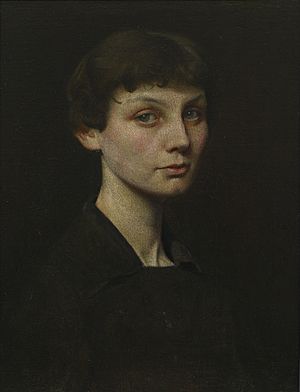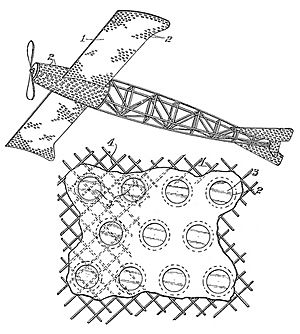Mary Taylor Brush facts for kids
Quick facts for kids
Mary Taylor Brush
|
|
|---|---|

1888 portrait of Brush by her husband
|
|
| Born |
Mary Taylor Whelpley
January 11, 1866 Boston, Massachusetts, United States
|
| Died | July 29, 1949 (aged 83) Dublin, New Hampshire, United States
|
| Resting place | Dublin Town Cemetery |
| Other names | "Mittie" Taylor Brush |
| Spouse(s) | George de Forest Brush (m. 1886–1941; his death) |
| Children | Eight, including Nancy Douglas Bowditch |
| Signature | |
Mary Taylor Brush (born January 11, 1866 – died July 29, 1949) was an American woman who was many things! She was an early aviator (someone who flies planes), an artist, a plane designer, and a pioneer in camouflage. This means she was one of the first people to come up with ideas for hiding things, especially planes.
Contents
Mary Taylor Brush's Life Story
Mary Taylor Whelpley was born in Boston, Massachusetts, on January 11, 1866. Her parents were Mary Louise Whelpley and James Davenport Whelpley.
Mary Taylor met George de Forest Brush when she was studying art. She was a student at the Art Students League of New York, and he was her teacher. They fell in love and got married in New York City in 1886. This was on her twentieth birthday!
Family Life and Homes
After they got married, Mary and George first moved to Quebec, Canada. They lived there for two years before coming back to New York. Later, in the 1890s, Mary's health wasn't great. So, they moved to Florence, Italy, for a short time so she could get better. They would visit Italy every year before World War I started.
Around 1890 or 1901, George bought a place called Townsend Farm in Dublin, New Hampshire. The family had spent vacations there before. They decided to move there permanently. Mary Taylor was often the main subject of her husband's paintings. He painted many pictures of her with their children, often called 'Mother and Child' artworks.
The Brush family even lived near Amelia Earhart for a while. Amelia Earhart was a very famous aviator. Mary Taylor and Amelia became good friends.
Mary Taylor Brush passed away on July 29, 1949, in Dublin, New Hampshire. She was buried in the Dublin Town Cemetery.
Mary Taylor Brush's Amazing Career
Mary Taylor Brush was an amazing person who loved to fly! She became a pilot before World War I began. She also designed and got patents for her own airplanes. A patent is like an official document that says you invented something.
Parts of one of her planes still exist today! They have been shown at the Eagles Mere Air Museum in Pennsylvania since 2011. Mary Taylor also worked on creating camouflage for aircraft. This means she found ways to make planes harder to see in the sky.
Pioneering Plane Camouflage
Mary, her husband George, their oldest son Gerome, and their friend Abbott H. Thayer all worked together. They designed ways to hide planes during World War I. They used their artistic skills to come up with ideas for military camouflage.
Mary first tested her husband's camouflage ideas. Then, she started trying out her own designs. She used a plane called a Morane-Borel monoplane that they bought in 1916. In 1917, Mary Taylor filed a patent for her invention. She said she could "produce a machine which is practically invisible when in the air."
How Her Camouflage Worked
Other artists working on camouflage used modern art techniques to change how colors looked. But Thayer and the Brushes were inspired by how animals hide in nature. They thought about how some animals have light bellies and dark backs to blend in.
One of their ideas was to paint the underside of planes a very light color. Another idea was called counter-illumination. This meant making the plane as bright as the sky around it. The goal was to make the plane seem clear or see-through.
George tried using shiny silk to cover a plane for counter-illumination. But it wasn't strong enough. Mary Taylor had a different idea. She decided to punch small holes in parts of the plane's linen wings. She also put light bulbs in different parts of the fuselage (the main body of the plane). These lights would scatter light around the plane.
She tested her designs by flying her plane over Long Island and New Hampshire. Her ideas were not used during World War I. However, her concept was looked at again and tested during World War II. This included a project called Yehudi lights.
See also
 In Spanish: Mary Taylor Brush para niños
In Spanish: Mary Taylor Brush para niños


